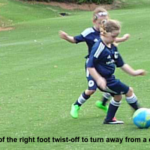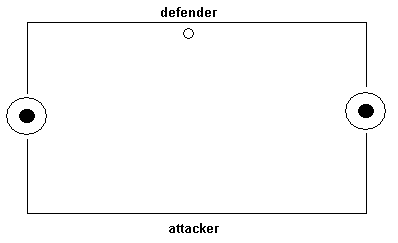Dribbling: quick links
- Basic dribbling skills
- Dribbling turns
- V-pull moves
- Stop and go moves
- Moves to get behind a defender
- Dribbling courses
- 1v1 dribbling games
If you want to test your dribbling turns, stop and go moves, and tricks against an opponent, here are some dribbling games you can play with one or more partners.
Dribbling games:
Electric fence:
We created a separate page related to the electric fence 1v1 dribbling game. Link: electric fence details.
Snow cones:
 This is a 1v1 game with multiple goals that works on dribbling to get away from a defender. This is similar to the Electric Fence game, but in Snow Cones, the defender is fully “live” and can steal the ball. The attacker can use turns, V-pulls, stop & go moves and fakes, along with changes of speed, to get away from the defender and score in an open goal.
This is a 1v1 game with multiple goals that works on dribbling to get away from a defender. This is similar to the Electric Fence game, but in Snow Cones, the defender is fully “live” and can steal the ball. The attacker can use turns, V-pulls, stop & go moves and fakes, along with changes of speed, to get away from the defender and score in an open goal.
Video demos:
Group demo (variation using small goals with shooting zones):
A nice goal!
 Setup a space about 12 yards long by 15 yards wide, with small goals on the middle of each sideline. The goals can be U6/U8 goals, small cone goals, or you can make “snow cone” goals by placing extra balls on cones or shoes to make them look like snow cones.
Setup a space about 12 yards long by 15 yards wide, with small goals on the middle of each sideline. The goals can be U6/U8 goals, small cone goals, or you can make “snow cone” goals by placing extra balls on cones or shoes to make them look like snow cones.
If you don’t have extra soccer balls, use your imagination for the snow cone goals — tennis balls, pine cones, water bottles, even old shoes will work just fine!
- An attacker starts at the center of one end-line, the defender starts on the other side with a ball.
- Play starts with the defender passing the ball to the attacker. (With younger players who are struggling with their passing, you can start with a Texas Draw [a 50-50 ball] in the center.)
- The attacker receives the ball: make sure you meet the ball instead of waiting on it.
- The attacker tries to score in one of the open goals, or knock the snow cone ball off its cone. Sounds easy, but the defender will probably get pretty close and make it hard. (The defender can steal the ball and score in either goal.) The key to success:
- There are two goals, but only one defender. One goal is bound to be open. Get your head up to see the defender. Either trick the defender and dribble past her, or turn away from the defender — just don’t dribble into her!
- Once you have a clear path to a goal, take a firm getaway touch directly toward that goal and accelerate into space — this will erase the defender from the play. Keep your body between the defender and the ball as you approach the goal.
- Switch roles after each turn. The attacker becomes the defender, and the defender becomes the attacker.
Variations:
- You must dribble into the snow cone (or cone goal) to score, instead of scoring by passing the ball into the snow cone.
- Move the goals off the field. You’ll need to dribble to create open space, but you’ll have to shoot the ball into the goal or snow cone to score.
- End-line goals: Move the goals from the sides of the field to the defender’s end line. This creates new angles to attack and makes it harder for the attacker.
- Wide zones: Create small wide zone strips on each side. The attacker must dribble into a wide zone, then back into the main part of the field before she can score. This forces the attacker to try extra dribbling moves, since she won’t be able to rely solely on speed.
Doubles:
- If you have four or more players, have two pairs play at the same time. The extra traffic adds a new challenge and puts an emphasis on heads-up dribbling.
Wrist girl:
This is a small-group game that combines dribbling and trickiness with agility activities. It works best with three or more players.
- One or more players carry colored vests or ribbons in their hands (we call them “wrist girls”). The other players are dribblers.
- The dribblers try to hit a wrist girl with their ball, below her knees. If a player does so, she becomes the wrist girl. The previous wrist girl drops the vest or ribbon and becomes a dribbler.
- The wrist girls get a lot of high-intensity running. They’ll use speed, agility, reaction, trickiness and quickness to get away from the dribblers.
- The dribblers get a lot of high-intensity dribbling touches. They have to get their heads up to locate the wrist girls, and they have to make lots of quick changes of direction and changes of speed to track down the wrist girls.
Trickiness also comes into play if you’re a dribbler, because you need to disguise your intentions. If the wrist girl sees you about to strike the ball, she’ll jump or turn away. So you’ll need to trick the wrist girl by sneaking up on her, or fool her by using the outside of your foot (or your toe) to hit her with minimal leg swing.
Dribbling marbles:
We created a separate page related to the dribbling marbles game. Link: dribbling marbles details
Dribbling chicken:
Video demos — turning away from a defender:
Video demos — beating (getting behind) a defender:
This isn’t a competitive game like the others, but it’s a quick way for two or more players to practice dribbling moves.
- Players start 5-10 yards apart, and then dribble at each other.
- Each player does a dribbling move before they collide. This could be a dribbling turn to go away from the other player, or a move to get behind the other player.
- Girls can play “freestyle,” or one player can call out a specific move as they dribble toward each other.
Dribbling chicken helps players learn how much space they need for different dribbling moves. If you bump into the other player, you’ll learn to try your move a little earlier. Let’s review how much space you need for dribbling turns:
- Pullbacks require the least amount of space, since you reach out and pull the ball back without ever moving your foot past the ball. That’s why pullbacks work well when there’s a defender in your face.
- U-turns and Cruyff turns require a little more space, because your foot moves past the ball during the turn.
- Stop turns and step-over turns require a lot more space, because your body moves past the ball during the turn.
